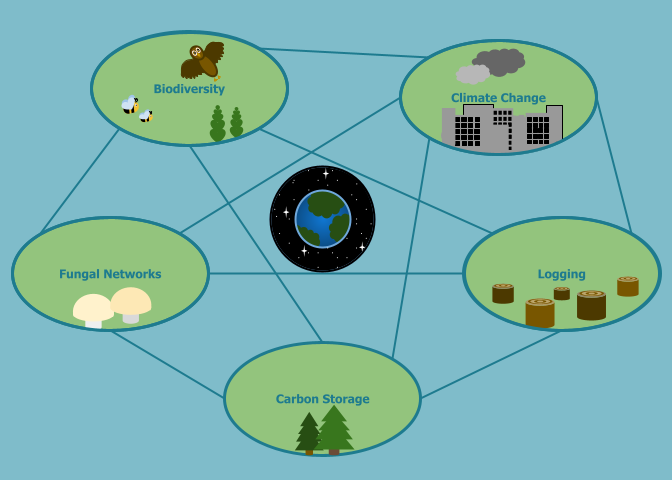Believe It or Not, It’s All Connected
Graphic Courtesy of Tracy Wilkinson
Logging, climate change, carbon storage, fungal networks, and biodiversity are all intricately interconnected. Changes to one impact all the others. By helping one, we help the rest, but by destroying one, we doom the others.
The Earth’s forests are extremely important for the health of the planet. We need the trees in the forest to make the oxygen we breathe every second of every day. Removing the forests is like removing a vital organ from your body. The planet just can’t function without them, which means we can’t either.
Unfortunately, many of humanity’s actions harm the planet in a variety of ways, and the consequences of those actions tend to amplify each other. For example, humans burn fossil fuels that release greenhouse gases into the atmosphere. Those greenhouse gasses cause the greenhouse effect and change the climate of the entire planet. To make matters worse, however, humans also log in highly destructive and completely unsustainable ways.
Let’s repeat that one more time...
Humans also cut down trees.
While it's true that humans have used trees for shelter and fuel for millennia, in modern times, we take advantage of the living organisms we all too often see as basic resources. We remove virgin forests at a terrifying pace and scale and often replace those forests with plantations that we log in shortened, unhealthy rotations.
Our actions have catastrophic impacts.
Because of their amazing carbon storage abilities, humanity’s greatest weapons to fight climate change are trees. Stated differently, as humans use one hand to figuratively set ourselves on fire by practicing unsustainable logging, we use the other to throw the only available water as far from ourselves as possible. When you think about it, it makes no sense whatsoever.
Furthermore, industrial logging not only reduces the tree mass available to remove carbon from the atmosphere, but it also releases stored carbon back into the atmosphere, perpetuating climate change. As a result of climate change, the types of fungal networks (which, as a reminder, help trees communicate, store carbon, and trade nutrients) that store carbon most efficiently are less fit for the environment because they prefer cooler temperatures. Without fungal networks, the trees aren’t as healthy and resilient, and the soil can’t store as much, which means even more carbon is released into the atmosphere.
Logging and climate change both decrease biodiversity. In addition to perpetuating climate change, logging can intensify forest fires, as it reduces habitat and disrupts ecosystems. Climate change has so many consequences it’s impossible to list them all, but some include increased temperatures, frequent extreme weather events, melting ice caps, and rising sea levels. All of these factors make it more difficult for species to live, leading to a decrease in biodiversity.
Many flora and fauna can’t handle the new conditions of their environments, and will therefore decline in population and either adapt or go extinct. The latter is more likely because of the fast pace of these environmental changes. Even the species that can handle the initial changes in their environment will be impacted by the loss of the other, less resilient species because that loss will rock the entire ecosystem. The surviving species that rely on the extinct ones for food, population control, or something else will be less stable after the decline and may go extinct, and the same process will then take place with the species that relied on them. Humans have caused a chain reaction that is currently unfolding under our very noses.
However, while the connections between aspects of nature and harmful forestry practices can serve to highlight the extent of human carelessness, there are also positive paths forward. Restoring forests and letting nature take its course would help not only combat the impacts of logging but those of biodiversity loss and climate change. It would sequester and store more carbon. It would allow fungal networks to thrive and work their magic to a further extent. Similarly, taking action against climate change would also help fungal networks to store carbon and assist trees (increasing carbon storage in the forest as a whole), strengthen the trees in the forest, and promote biodiversity.
A forest is a beautiful balance of large and small, life and death, and growth and decay. It is more than a group of trees, or even a habitat. It is one of the planet’s regulatory mechanisms; it affects the composition of the atmosphere. It is home to unbelievable life.
Humans have the power to utterly desecrate the planet’s forests. But we also have the power to protect them. We have been the Earth’s biggest problem. We can also be the solution.
Learn More!
Logging Fungal Networks Biodiversity Climate Change Carbon Storage Solutions & News
